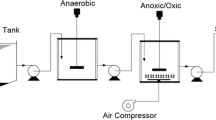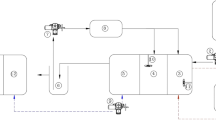Abstract
A simulated wastewater containing phenol (1,000–2,500 mg/L), thiocyanate (SCN−) of 800 mg/L, COD (4,200–8,150 mg/L), and ammonia–nitrogen (NH4 +–N) of 500 mg/L was treated in a sequential anaerobic (B1)–anoxic (B2)–aerobic (B3) batch fed moving-bed reactor (MBR) system. Total hydraulic retention time (HRT) was varied from 5 to 10 days with B1 2.5 to 5 days; B2 and B3: 1.25–2.5 days each. In B1, 25–63 % of phenol and 23–53 % of COD removals were achieved and feed phenol above 1,500 mg/L, inhibited COD and phenol removals in B1. In B2, more than 90 % phenol removal was achieved along with COD removal and denitrification. In B2, with increase in phenol loading, though phenol and COD removal rates increased, SCN− removal rate decreased above phenol loading of 0.28 g/L day. In B3, NH4 +–N removal efficiency decreased above loading of 0.24 g NH4 +–N/L day. The overall efficiency of the fed batch MBR system was independent of feed phenol concentration up to 2,500 mg/L at constant total HRT of 6 days. NH4 +–N removal efficiency deteriorated significantly, when total HRT of fed batch MBR was less than 6 days. Modified Stover–Kincannon model showed the best fit for removal of substrates in three reactors and Haldane’s inhibition model predicted NH4 +–N removal in B3.





Similar content being viewed by others
References
Ahn JH, Forster CF (2002) A comparison of mesophilic and thermophilic anaerobic up flow filters treating paper–pulp-liquors. Process Biochem 38:257–262
APHA, AWWA, WPCF (1998) Standard methods for the examination of water and wastewater. 20th edn, American Public Health Association, Washington
Banerjee G (1996) Phenol- and thiocyanate-based wastewater treatment in RBC reactor. J Environ Eng 122:941–948
Cappuccino JG, Sherman N (1998) Microbiology: a laboratory manual Fifth edition. Benjamin/Cummings Science Publishing, California
Chakraborty S, Veeramani H (2006) Effect of HRT and recycle ratio on removal of cyanide, phenol, thiocyanate and ammonia in an anaerobic–anoxic–aerobic continuous system. Process Biochem 41:96–105
Chen S, Sun D, Chung J (2008) Simultaneous removal of COD and ammonium from landfill leachate using an anaerobic–aerobic moving bed biofilm reactor system. Waste Manage 28:339–346
Grau P, Dohanyas M, Chudoba J (1975) Kinetics of multicomponent substrate removal by activated sludge. Water Res 9:337–342
Jeong YS, Chung JS (2006) Simultaneous removal of COD, thiocyanate, cyanide and nitrogen from coal process wastewater using fluidized biofilm process. Process Biochem 41:1141–1147
Johnson CH, Page MW, Blaha L (2000) Full scale moving bed biofilm reactor results from refinery and slaughterhouse treatment facilities. Water Sci Technol 41:401–407
Kim YM, Park D, Jeon C, Lee DS, Park JM (2008) Effect of HRT on the biological pre-denitrification process for the simultaneous removal of toxic pollutants from cokes wastewater. Bioresource Technol 99:8824–8832
Kowalska M, Bodzek M, Bohdziewicz J (1998) Biodegradation of phenols and cyanides using membranes with immobilized microorganisms. Process Biochem 33(2):189–197
Kuscu OS, Sponza DT (2009) Kinetics of para-nitrophenol and chemical oxygen demand removal from synthetic wastewater in an anaerobic migrating blanket reactor. J Hazard Mater 161:787–799
Li YM, Gu GW, Zhao JF, Yu HQ, Qiu YL, Peng YZ (2003) Treatment of coke- plant wastewater by biofilm systems for removal of organic compounds and nitrogen. Chemosphere 52:997–1005
Li H, Han H, Du M, Wang W (2011) Removal of phenol, thiocyanate and ammonium from coal gasification wastewater using moving bed biofilm reactor. Bioresource Technol. 102:4667–4673
Movahedin H, Shokoohi R, Parvaresh A, Hajia MJ, Jafari A (2006) Evaluating the Effect of glucose on phenol removal efficiency and changing the dominant microorganisms in the serial combined biological system. J Res Health Sci 6:8–13
Rusten B, Siljudalen JG, Wien A, Eidem D (1998) Biological pre-treatment of poultry processing wastewater. Water Sci Technol 38:19–28
Sa CSA, Boaventura RAR (2001) Biodegradation of phenol by Pseudomonas putida DSM 548 in a trickling bed reactor. Biochem Eng J 9:211–219
Sahariah BP, Chakraborty S (2011) Kinetic analysis of phenol, thiocyanate and ammonia-nitrogen removals in an anaerobic–anoxic–aerobic moving bed bioreactor system. J Hazard Mater 190:260–267
Saravanan P (2008) Biodegradation of phenolic compounds, PhD thesis, submitted to Indian Institute of Technology Guwahati, Guwahati
Sigrun JJ, Jukka AR, Ødegaard H (2002) Aerobic moving bed biofilm reactor treating thermomechanical pulping white water under thermophilic condition. Water Res 36:1067–1075
Sorokin DY, Tourova TP, Antipov AN, Muyzer G, Kuenen JG (2004) Anaerobic growth of the haloalkaliphilic denitrifying sulphur-oxidizing bacterium Thialkalivibrio thiocyanodenitrificans sp. nov. with thiocyanate. Microbiology 150:2435–2442
Thomas S, Sarfaraz S, Mishra LC, Iyengar L (2002) Degradation of phenol and phenolic compounds by a defined denitrifying bacterial culture. World J Microbiol Biotechnol 18:57–63
Vàzquez I, Rodriguez J, Maranon E, Castrillon L, Fernandez Y (2006) Study of the aerobic biodegradation of coke wastewater in a two and three-step activated sludge process. J Hazard Mater B137:1681–1688
Zheng S, Li W (2009) Effects of hydraulic loading and room temperature on performance of anaerobic/anoxic/aerobic system for ammonia–reidden and phenol rich coking effluents. Desalination 247:362–369
Zhu W, Huang X, Lee D (2009) Enhanced treatment of coke plant wastewater using an anaerobic–anoxic–oxic membrane bioreactor system. Sep Purif Technol 66:279–286
Acknowledgments
Dr. Saswati Chakraborty would like to thank Ministry of Environment & Forest (MoEF), Govt. of India (No. 19-18/2003-RE) for financial support to this study.
Author information
Authors and Affiliations
Corresponding author
Rights and permissions
About this article
Cite this article
Sahariah, B.P., Chakraborty, S. Performance of anaerobic–anoxic–aerobic batch fed moving-bed reactor at varying phenol feed concentrations and hydraulic retention time. Clean Techn Environ Policy 15, 225–233 (2013). https://doi.org/10.1007/s10098-012-0499-9
Received:
Accepted:
Published:
Issue Date:
DOI: https://doi.org/10.1007/s10098-012-0499-9




